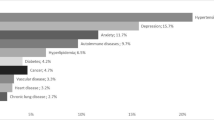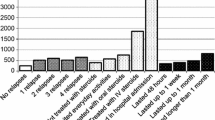Abstract
This cost-of-illness analysis for Belgium is part of a Europe-wide study on the costs of multiple sclerosis (MS). The objective was to analyze the costs and quality of life (QOL) related to the level of disease severity. Patients from four specialized MS centres participated in the survey by answering a mail questionnaire. In addition to details on the disease (type of disease, relapses, level of functional disability), the questionnaire asked for information on all medical and non-medical resource consumption, sick leave, early retirement, informal care as well as QOL (in the form of utility weights). A total of 799 respondents were included in the analysis (response rate 38%). The mean age of the cohort was 48 years, and 12% of patients were 65 years or older. Forty-six percent of patients had mild disease (Expanded Disability Status Scale [EDSS] score 0–3), 20% severe disease (EDSS score ≥7), and the mean EDSS score in the sample was 4.2 (median 4.0), with a utility of 0.51. Costs and utility are highly correlated with disease severity. Workforce participation decreases from approximately 75 to 80% in early disease to approximately 6% in the very late stages. Hospitalization and ambulatory visits increase by a factor of 10 between early and late disease; investments and services increase from basically no cost to € 6.000 to € 7.000 per year; productivity losses increase ninefold; and informal care increases from € 300 per year at an EDSS score of 0–1 to € 15.000 to € 16.000 per year at an EDSS score ≥7. Hence, total mean costs per patient are driven essentially by the distribution of the severity levels in the sample, increasing from approximately € 12.000 per year at an EDSS score of 0–1 to € 51.500 per year at an EDSS score of 8-9. The same is true for utility, which decreases from 0.85 to 0.06 as the disease becomes severe. However, the utility loss compared to the general population is high at all levels of the disease (0.25 at an EDSS score of 2 to 0.44 at an EDSS score 5–6 leading to an estimated loss of 0.3 quality-adjusted life-year (QALY) per patient. Relapses for patients with an EDSS score <5 are associated with a cost of approximately € 3.360 and a utility loss of 0.1 during the quarter in which they occur. Public payers (health-care costs, community care, sick payments and invalidity pensions) cover an estimated 55% of all costs.





Similar content being viewed by others
References
Kobelt G, Berg J, Lindgren P, Fredrikson S, Jönsson B (2006) Costs and quality of life of multiple sclerosis. Eur J Neurol (In press)
Kurtzke J (1983) Rating neurological impairment in multiple sclerosis and expanded disability status scale (EDSS). Neurology 33: 1444–1452
Rosati G (2001) The prevalence of multiple sclerosis in the world: an update. Neurol Sci 22: 117–139
Carton H, Loos R, Pacolet J, Versieck K, Vlietinck R (1998) Utilisation and cost of professional care and assistance according to disability of patients with multiple sclerosis in Flanders (Belgium). J Neurol Neurosurg Psychatry 66: 256–257
The EuroQol Group (1990) EuroQol – a new facility for the measurement of health-related quality of life. Health Policy 16: 199–208
Dolan P, Gudex C, Kind P, Williams A (1995) A social tariff for EuroQol: results from a UK general population survey (York, Centre for Health Economics, University of York). Discussion paper 138 (September 1995)
Pugliatti M (2006) The prevalence and incidence of multiple sclerosis in Europe. J Neurology (In press)
Carton H, Loos R, Pacolet J, Versieck K, Vlietinck R (2000) A quantitative study of unpaid care giving in multiple sclerosis. Mult Scler 6: 274–279
Kobelt G, Lindgren P, Parkin D, Jönsson B (2000) Costs and quality of life in multiple sclerosis. A cross-sectional observational study in the United Kingdom. SEE/EFI Working Paper Series in Economics and Finance No. 399. Stockholm School of Economics; Stockholm, Sweden
Kobelt G, Lindgren P, Smala A, Jönsson B, Group Gms (2001) Costs and quality of life in multiple sclerosis. A cross-sectional observational study in Germany. Eur J Health Econ 2: 60–68
Contributions:
Danny Decoo, MD (Elisabeth Ziekenhuis, Sijssele); Daniel Guillaume MD (Centre Neuroloogique d’Adaptation Fonctionnelle, Fraiture); Niels Neymark (Consultant, Brussels), Christian Sindic MD (Cliniques Universitaires Saint-Luc, Woluwe-Saint Lambert, Bruxelles) ; Luc Vandegaer MD (MS Revalidatiecentrum, Overpelt)
Acknowledgements
Ulrika Lilja (Stockholm Health Economics, Sweden)
Conflict of interest
No information supplied.
Author information
Authors and Affiliations
Corresponding author
Rights and permissions
About this article
Cite this article
Kobelt, G. Costs and quality of life for patients with multiple sclerosis in Belgium. Eur J Health Econ 7 (Suppl 2), 24–33 (2006). https://doi.org/10.1007/s10198-006-0377-7
Issue Date:
DOI: https://doi.org/10.1007/s10198-006-0377-7




